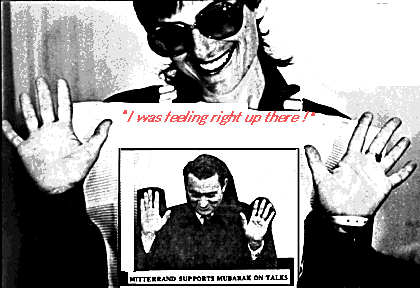
Similar gestures from USA (above) and Egypt express contentment.

Mudra is from Sanskrit and means gesture. Digital Mudra is a
multimedia-interdisciplinary
installation in which viewer participants interact with a computer. They
recompose Mudra word meanings and images into linear extensions of
gesture
language in the aesthetic layerings of poetry, dance and philosophy.
Cross-cultural
differences and similarities of hand gestures and their trans-cultural
meanings
are revealed in an environment that includes slide projections of topical
personalities unwittingly using ancient Mudra gestures. This demonstrates
cultural congruences and contrasts as the gesticulating personalities
are
juxtaposed with slides of similar Mudra gestures. A videotape of Mudra
gestures
presents Kathakali dancer Kunhiraman interpreting into dance form the
poems
participants had created at an earlier time using words from the Mudra
word
list.
The source for the selected Mudra word list is exhibited in a wall
Glossary
of plexi-glass see-through boxes. On the covers of the boxes are
drawings
of Mudra gestures. These drawing overlay photographs of similar western
gestures that are inside the box. The photographs had been taken at a
previous
Rapoport event, Biorhythm, where participants were asked to
express
with their hands "how they were feeling" that evening.
Viewers becomes participants at the computer where they create a poetic
phrase from three key words in the Mudra word list. The word-Mudra images
have been printed on 3" x 5" cards from which the participant
can select the key words. These words are typed into the computer. The
Mudra
images that correspond to the key words become transcribed into a
Kathakali
gesture dance on the screen. The Kathakali dance positions are printed
and
then interpreted by a visiting "philosopher" to convey a
philosophic
guideline from the writings of Rabindranath Tagore.
A "golden" wall of temple writings is created by participants
hanging gilded aluminum tag icon duplicates of the word-gesture card
selections.
In a variable format of 10 feet in width, an acrostic can be created in
which the tags (3" x 5") can be moved about to make new and
meaningful
phrases. An electric fan situated behind the wall effectively moves the
tags back and forth as if in a dance.
KALA Institute in Berkeley , California initiated and presented this
installation
in 1987. Digital Mudra, in book format, was sponsered by the
United
States Information Agency to travel world-wide in a book exhibition from
1990-1992.
John Watkins was the computer design engineer.